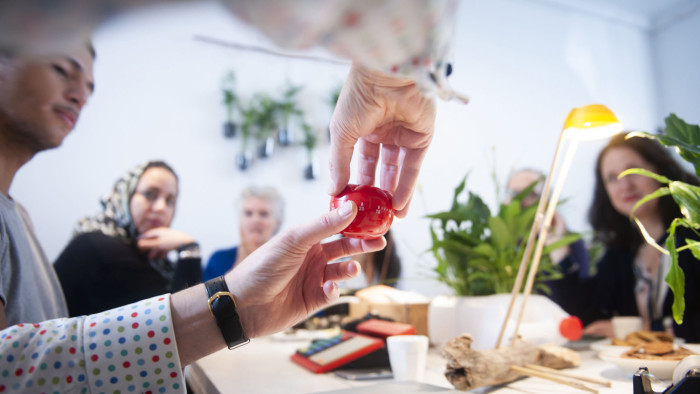Productivity hacks to love or loathe

Roula Khalaf, Editor of the FT, selects her favourite stories in this weekly newsletter.
Could the humble kitchen timer help end productivity woes?
Carl Cederström, a business school academic, thinks so. Having tried and ditched several high-tech tools, he credits the analogue Pomodoro Technique for helping him get work done.
This simple system, developed in the 1980s by Francesco Cirillo, is named after the tomato-shaped kitchen timer Mr Cirillo used to help him study. The idea is to set a timer for 25 minutes to focus on one task, have a five-minute break, work another 25 minutes, and so on.
“I’ve been using it for years and it’s the most revolutionary method I have tried,” says Mr Cederström, associate professor at Stockholm University.
It is particularly useful in today’s open-plan workspaces, he says. They are designed to help workers be social and to network — but there are so many distractions.
“The great irony is that we talk about work taking over our lives, but one of the greater sources of work-related stress is that we don’t actually get to do any work.”
Even when we manage to remove all distractions, we still have to wrestle with our greatest enemy — ourselves.
Technological advances promised to help lift global productivity rates, but this has not yet happened. We have all the tools and technology to make us more productive, but do they actually help?
So-called productivity hacks and tools offer remedies to our troublesome tendency to procrastinate. At one extreme are products such as Kitchen Safe. You put your phone in the plastic box and set a time. The only way to retrieve the phone before the time limit is to break into the box.
The problem with such tools is that their goal is not to improve your productivity, but to make you use the application more, says Laszlo Bock, chief executive of tech company Humu and former head of people operations at Google. The companies that build these products are measured by their investors on engagement, not on how productive the user becomes.
“People love dials and knobs, and bells and whistles. There are lots of things that make it feel like work, but are in fact noise and distraction,” says Mr Bock.
There is no measurable return on investment on productivity with these tools, says Mr Bock. Many rely on notifications, triggering positive reinforcement to keep you checking, releasing a dopamine hit to your brain. The risk is that you spend more time managing the tool than doing productive work.
What can corporate leaders of the future learn from today’s experts at getting work done? We asked five users of productivity tools and hacks what helps and what does not.

Carl Cederström, associate professor at Stockholm University, and co-author of Desperately Seeking Self-Improvement
The only time I really relax is on an aeroplane, when there is no way for people to reach you. Now I check email only twice a day: 9am-10am and then 3pm-4pm.
It is difficult to stay focused on one task when you are alone, so having someone there to speak to when you have a break helps. I often work with a freelancing friend at the kitchen table and we listen to the same playlist each time — we haven’t changed it for years.
When I feel panic-stricken about a task, I repeat a mantra I read in Haruki Murukami’s memoir, What I Talk About When I Talk About Running, which the author uses when he feels he cannot run any further: ‘I’m not human. I’m a piece of machinery . . . Just forge on ahead’.
I also keep a strange notebook, which I write in like a grown-up speaking to a child. I write things like “OK, so what really is it that you should be doing right now?” and respond with answers . . . I’m a little embarrassed speaking about it, but it works.
What works: The Pomodoro Technique to help me focus. And the word processing app Scrivener for writing, diaries and calendars. I try to minimise my technology use, but when something pops up that I want to record I use Braintoss, a tool to capture information — you take a photo or record a voice memo, which the app sends to your email.
What doesn’t: Flowstate , a writing app that deletes your work if you stop for more than a few seconds. It was really stressful. Sometimes I want to go slow.

Laszlo Bock, chief executive and co-founder of Humu, former senior vice-president of people at Google, and author of Work Rules!
Notifications are a nightmare. I have them turned off on every device. I keep Gmail and Slack open at my desk, but Twitter and LinkedIn are in a folder so that it’s harder to get to them.
I keep three folders in Gmail: one is checked quarterly, one monthly, and one on Thursdays. At Google, I worked with a guy named Jonathan who ran the product team. For the first year, he would always be following up with me on tasks, hounding me, and I felt like I was failing because he was always one step ahead.
Then I realised he always followed up on a Friday, so I set up a folder called “check Thursday”. Two months later Jonathan said, “I don’t know what’s happened but you’ve really turned things around”. (It turns out he had a “check Friday” folder).
What works: Email folders: I either respond within 12 hours or it goes into one of the folders. It feels polite to let people know you’ve received it.
What doesn’t: One colleague tried tracking time with Toggl but it was too much effort; another tried Getting Things Done, but spent too long making lists.

Marcela Sapone, chief executive and co-founder, Hello Alfred
Tech is often the biggest distraction. Unplugging from the noise and going offline helps catalyse different ways of thinking and really boosts creativity. I set out to accomplish outcomes versus tasks or to-do’s. I visualise the end-state of what my team and I need to achieve; and that becomes the North Star that keeps all those steps or tasks along the way on track and in perspective.
What works: My daily go-to is the note-taking service Google Keep — I like the simple list user interface. It also syncs across my devices and copies straight to my email and Google docs, which my team and I rely on.
What doesn’t: I’ve tried Asana and Trello but they didn’t stick. They’re great platforms for cross-functional projects but I found them overkill for what I needed.

Josh Bayliss, chief executive, Virgin Group
Problems that arise out of nowhere can feel like a challenge to your productivity, but any leader needs to be agile and responsive. Sometimes I turn off emails, freeing myself up to get on with the real to-do list. If there is a true emergency and somebody really needs your input urgently, they will find you.
Hour-long meetings are often booked out of habit. I make sure everyone is clear on why they are in the room and what everyone wants to get out of it.
What works: Shorter meetings, letting emails wait and making time for exercise.
What doesn’t: A few years ago at Virgin we introduced a “digital detox” policy — switching off the email server for a couple of hours each week. Some embraced it more than others. Now we have adapted the policy so it is not so strict, but still nudges teams to leave their screens and get social for a little while.

Pocket Sun, co-founder and managing partner, SoGal Ventures
It’s important to figure out what motivates you, what’s your purpose — and do people you work with share the same purpose? If these things are figured out, productivity itself is easy, because your work has significance.
Phone notifications stop me being productive — I now leave my phone somewhere I can’t reach it when I’m working on my laptop. Listening to classical music or podcasts helps me focus and I also have a morning routine — deep breathing when I wake up, putting on upbeat music.
Setting goals, breaking them down into quarters, months, and specific tasks with deadlines helps bring clarity to what needs to happen when.
What works: the Chinese superapp, WeChat, which people do everything on, from text and video conversations with family, friends and colleagues, to running online communities, transferring money or documents, or booking flights and hotels.
What doesn’t: Project management software hasn’t worked for me so far. I still like writing things down on paper or in the notes app on my phone.

Comments